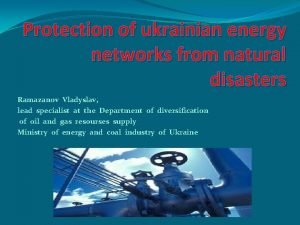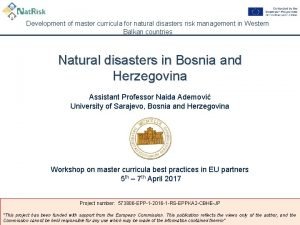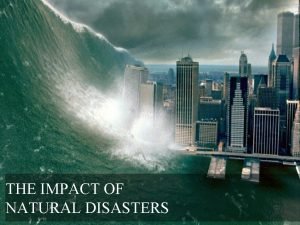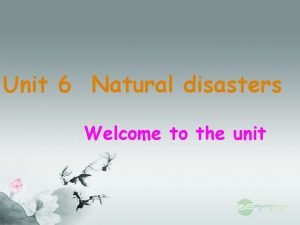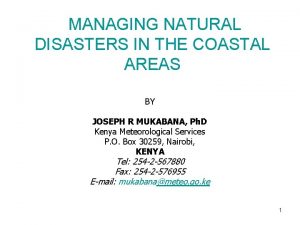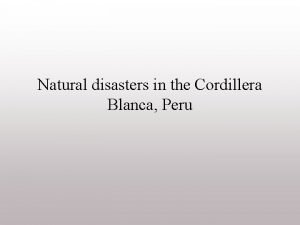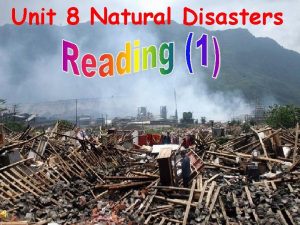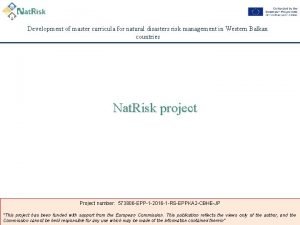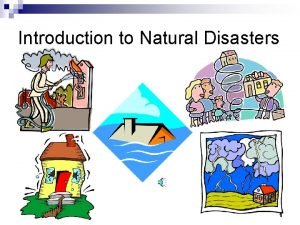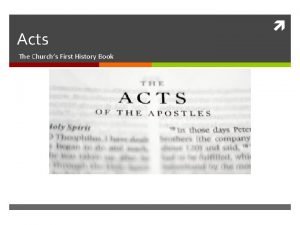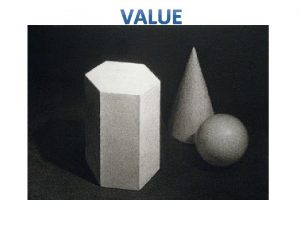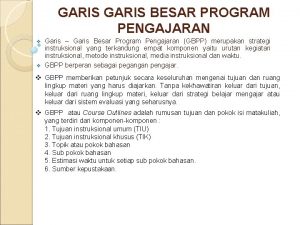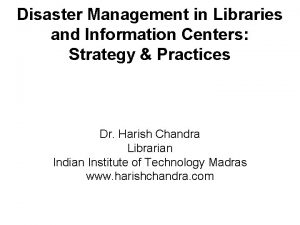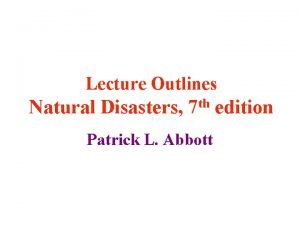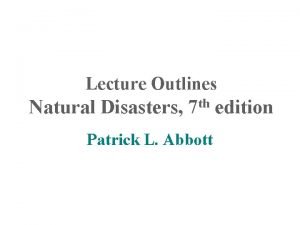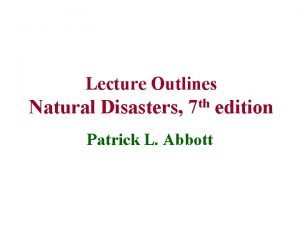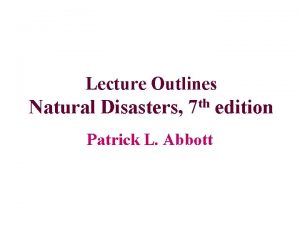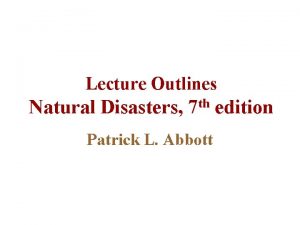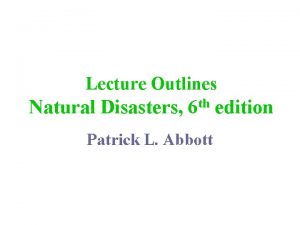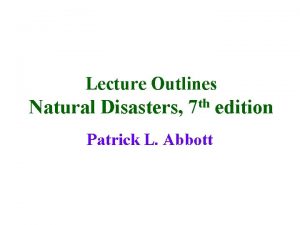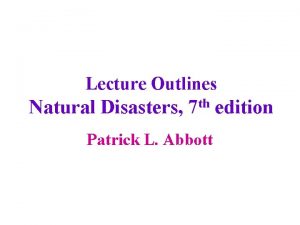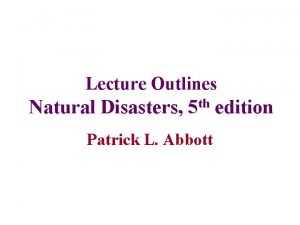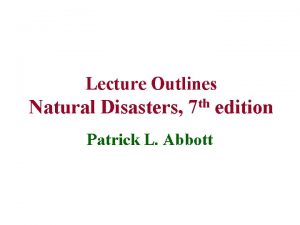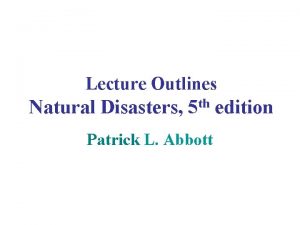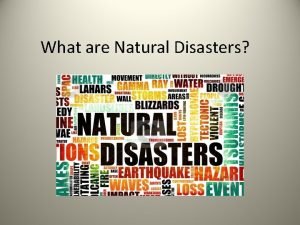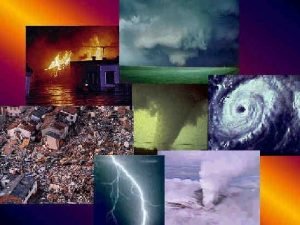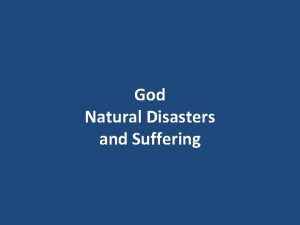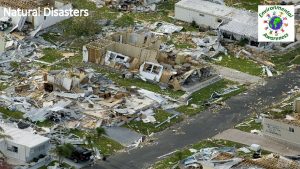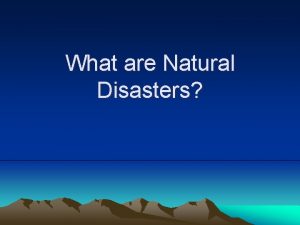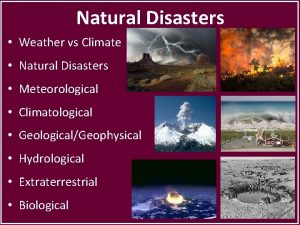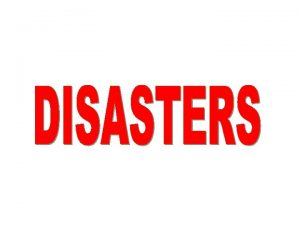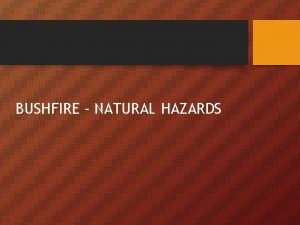Lecture Outlines Natural Disasters 7 th edition Volcanic
































- Slides: 32

Lecture Outlines Natural Disasters, 7 th edition

Volcanic Eruptions: Plate Tectonics and Magma

Vesuvius, 79 C. E. • Cities of Pompeii and Herculaneum buried by massive eruption which blew out about half of Mt. Vesuvius • Similar to 1991 eruption of Mt. Pinatubo in Philippines • Clouds of hot gas (850 o. C), ash and pumice enveloped city • Many tried to escape near sea, but were buried by pyroclastic flows Figure 8. 1 Figure 8. 3

Vesuvius, 79 C. E. • Vesuvius was inactive for 700 years before 79 CE eruption – People lost fear and moved in closer to volcano • After 79 CE, eruptions in 203, 472, 512, 685, 993, 1036, 1049, 1138 -1139 • 500 years of quiet, then 1631 eruption killed 4, 000 people • 18 cycles of activity between 1631 and 1944, nothing since then • 3 million people live within danger of Vesuvius today; 1 million people on slopes of volcano

The Hazards of Studying Volcanoes • Eruptive phases are often separated by centuries of inactivity, luring people to live in vicinity (rich volcanic soil) – 400, 000 people live on flanks of Galeras Volcano in Colombia • Many people killed each year by volcanoes, sometimes including volcanologists • Volcanoes may be active over millions of years, with centuries of inactivity

How We Understand Volcanic Eruptions • Understand volcanoes in context of plate tectonics • Variations in magma’s chemical composition, ability to flow, gas content and volume determines whether eruptions are peaceful or explosive

Plate-Tectonic Setting of Volcanoes • 90% of volcanism is associated with plate boundaries – 80% at spreading centers – About 10% at subduction zones • Remaining 10% of volcanism occurs above hot spots Figure 8. 5

Plate-Tectonic Setting of Volcanoes • Subduction carries oceanic plate (with water-rich sediments) into hotter mantle, where water lowers melting temperature of rock • Rising magma melts continental crust it passes through, changing composition of magma Figure 8. 6

Plate-Tectonic Setting of Volcanoes • No volcanism associated with transform faults or continent collisions • Oceanic volcanoes are peaceful • Subduction-zone volcanoes are explosive and dangerous – Subduction zones last tens of millions of years – Volcanoes may be active any time, with centuries of quiet Figure 8. 6

Chemical Composition of Magmas • Of 92 naturally occurring elements: – Eight make up more than 98% of Earth’s crust – Twelve make up 99. 23% of Earth’s crust – Oxygen and silicon are by far most abundant • Typically join up as Si. O 4 tetrahedron, that ties up with positively charge atoms to form minerals Figure 8. 7

Chemical Composition of Magmas • Mineral formation in magma: crystallization • Order of crystallization of different minerals in magma can be determined: – Iron and magnesium link with aluminum and Si. O 4 to form olivine, pyroxene, amphibole and biotite families – Calcium combines with aluminum and Si. O 4 until calcium replaced by sodium, to form plagioclase feldspar family; calcium and sodium are later replaced by potassium, to form potassium feldspar and muscovite families; finally only Si and O remain, forming quartz

Chemical Composition of Magmas Figure 8. 8

Chemical Composition of Magmas • Elements combine to form minerals • Minerals combine to form rocks • Different compositions of magma result in different igneous rocks • If magma cools slowly and solidifies beneath surface plutonic rocks • If magma erupts and cools quickly at surface volcanic rocks

Viscosity, Temperature and Water Content of Magmas • Viscosity: internal resistance to flow – Lower viscosity more fluid behavior • Water, melted ice-cream – Higher viscosity thicker • Honey, toothpaste • Viscosity determined by: – Higher temperature lower viscosity – More silicon and oxygen tetrahedra higher viscosity – More mineral crystals higher viscosity • Magma contains dissolved gases: volatiles – Solubility increases as pressure increases and temperature decreases

Viscosity, Temperature and Water Content of Magmas • Consider three types of magma: basaltic, andesitic and rhyolitic – Basaltic magma has highest temperatures and lowest Si. O 2 content, so lowest viscosity (fluid flow) – Rhyolitic has lowest temperatures and highest Si. O 2 content, so highest viscosity (does not flow) – Basaltic makes up 80% of magma that reaches Earth’s surface, at spreading centers, because it forms from melting of mantle – Melted mantle at subduction zones rises through continental crust before reaching the surface, incorporating continental high Si. O 2 rock as it rises, to become andesitic or rhyolitic in composition before it erupts

Viscosity, Temperature and Water Content of Magmas

Viscosity, Temperature and Water Content of Magmas • Water is most abundant dissolved gas in magmas • As magma rises, pressure decreases, water becomes steam bubbles – Basaltic magma has lower water content peaceful, safe eruptions – Rhyolitic magma has higher water content and high viscosity many steam bubbles form and can not escape through thick magma, so explode out violent, dangerous eruptions Figure 8. 9 Figure 8. 10

Plate-Tectonic Setting of Volcanoes Revisited • Spreading centers have abundant volcanism because: – Sit above hot asthenosphere – Asthenosphere has low Si. O 2 – Plates pull apart so asthenosphere rises and melts under low pressure, changing to high-temperature, low Si. O 2, low volatile, low viscosity basaltic magma that allows easy escape of gases peaceful eruptions

Plate-Tectonic Setting of Volcanoes Revisited • Subduction zones have violent eruptions because: – Magma is generated by partial melting of the subducting plate with water in it – Melts overlying crust to produce magmas of variable composition – Magma temperature decreases while Si. O 2, water content and viscosity increase violent eruptions Figure 8. 11

How a Volcano Erupts • Begins with heat at depth – Rock that is superheated (heated to above its melting temperature) will rise – As it rises, it is under less and less pressure so some of it melts (becomes magma) – Volume expansion leads eventually to eruption • Three things will cause rock to melt: – Lowering pressure – Raising temperature – Increasing water content • Lowering pressure is most common way to melt rock decompression melting

How a Volcano Erupts • Magma at depth is under too much pressure for gas bubbles to form (gases stay dissolved in magma) Figure 8. 12 • As magma rises toward surface, pressure decreases and gas bubbles form and expand, propelling the magma farther up • Eventually gas bubble volume may overwhelm magma, fragmenting it into pieces that explode out as a gas jet

How a Volcano Erupts Eruption Styles and the Role of Water Content • Concentration of water in magma largely determines peaceful or explosive eruption • Basaltic magma can erupt violently with enough water • Rhyolitic magma usually erupts violently because of high water content, high viscosity (secondary role) Figure 8. 14 • Styles of volcanic eruptions – Nonexplosive Icelandic and Hawaiian – Somewhat explosive Strombolian – Explosive Vulcanian and Plinian

How a Volcano Erupts Some Volcanic Materials • Low-water content, lowviscosity magma lava flows • High-water content, high-viscosity magma pyroclastic debris

How a Volcano Erupts Nonexplosive eruptions • Pahoehoe: smooth ropy rock from highly liquid lava • Aa: rough blocky rock from more viscous lava Figure 8. 15 Figure 8. 16

How a Volcano Erupts Explosive eruptions • Pyroclastic debris: broken up fragments of magma and rock from violent gaseous explosions, classified by size • May be deposited as: – Air-fall layers (settled from ash cloud) – High-speed, gas-charged pyroclastic flow Figure 8. 17 a Figure 8. 18

How a Volcano Erupts Explosive eruptions • Very quick cooling: – Obsidian: volcanic glass forms when magma cools very fast – Pumice: porous rock from cooled froth of magma and bubbles Figure 8. 19

Side Note: How a Geyser Erupts • Geyser: eruption of water superheated by magma • Can only exist in areas of high heat flow underground • Water boils (becomes gas) at 100 o. C unless it is under pressure – no room for expansion to gas state – Water can be heated to higher than boiling temperature superheated – When superheated water reaches point of lower pressure, it flashes to steam violently, and erupts out of the ground Figure 8. 20

The Three V’s of Volcanology: Viscosity, Volatiles, Volume • Viscosity may be low or high – Controls whether magma flows easily or piles up • Volatile abundance may be low, medium or high – May ooze out harmlessly or explode • Volume may be small, medium or large – Greater volume more intense eruption

The Three V’s of Volcanology: Viscosity, Volatiles, Volume • By mixing different values for the three V’s, can forecast different eruptive styles for volcanoes

The Three V’s of Volcanology: Viscosity, Volatiles, Volume • By mixing different values for the three V’s, can define different volcanic landforms

The Three V’s of Volcanology: Viscosity, Volatiles, Volume Shield Volcanoes: Low Viscosity, Low Volatiles, Large Volume • Basaltic lava with low viscosity and low volatiles flows to form gently dipping, thin layers • Thousands of layers on top of each other form very broad, gently sloping volcano like Mauna Loa in Hawaii • Great width compared to height Figure 8. 22

The Three V’s of Volcanology: Viscosity, Volatiles, Volume Hawaiian-type Eruptions • “Curtain of fire”: lines of lava fountains up to 300 m high • Low cone with high fountains of magma – Floods of lava spill out and flow in rivers down slope – Eruptions last days or years, usually not life-threatening but destroy buildings and roads Figure 8. 24
 Natural hazards vs natural disasters
Natural hazards vs natural disasters Natural disasters conclusion for project
Natural disasters conclusion for project Natural disasters listening
Natural disasters listening Natural disasters
Natural disasters Ancient natural disasters
Ancient natural disasters Define natural disasters
Define natural disasters Environmental effect of disaster
Environmental effect of disaster Ancient natural disasters
Ancient natural disasters Unit 9 natural disasters
Unit 9 natural disasters Three natural disasters
Three natural disasters Introduction natural disasters
Introduction natural disasters Natural disasters in the cordillera region
Natural disasters in the cordillera region Natural disasters conclusion for project
Natural disasters conclusion for project Taiwan earthquake
Taiwan earthquake Natural disasters
Natural disasters Disaster definition
Disaster definition 01:640:244 lecture notes - lecture 15: plat, idah, farad
01:640:244 lecture notes - lecture 15: plat, idah, farad Book of acts outline
Book of acts outline Ksf outlines
Ksf outlines Four main components for effective outlines
Four main components for effective outlines Define visible
Define visible Naruto anime outline
Naruto anime outline Teaching outlines
Teaching outlines Exegetical outline example
Exegetical outline example Mucoepidermoid carcinoma histology
Mucoepidermoid carcinoma histology A business plan is a document that outlines
A business plan is a document that outlines Foecolith
Foecolith Two types of outlines
Two types of outlines Prison ministry training manual download
Prison ministry training manual download Cjis security levels
Cjis security levels Pyelonephritis
Pyelonephritis A clear concise document which outlines preventive
A clear concise document which outlines preventive A haunted house virginia woolf analysis
A haunted house virginia woolf analysis

